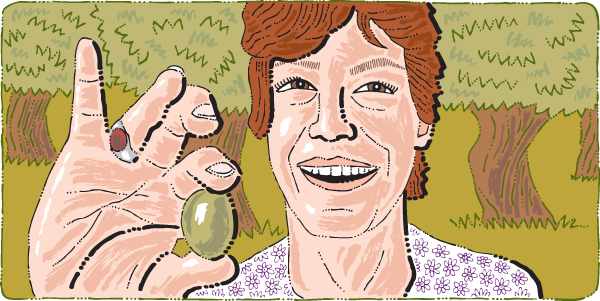Molise is one of Italy’s forgotten provinces. Sandwiched between Abruzzo and Puglia, a two hour drive due east of Rome, Molise doesn’t have any fashionable cities, no luxury waterfront, zero famous foods. What it has are ingredients. Grapes, wheat, and olives, which, for the most part, are sold in bulk for companies in other more famous provinces to pack into brand name exports.
Marina Colonna is an exception in a few ways.
One, she farms in Molise and she doesn’t sell ingredients; she makes her own olive oil with her own name on it. Two, the name on the oil is of a woman—in a very male business.
Third, and perhaps most interesting for us olive oil lovers, Marina grows a range of olives but presses them all separately and stores them separately. Her oil barn—which I’m sure has a way better name in Italian but I forgot to ask—is covered in wisteria and sits next to a patch of prickly pears. It’s cool when you enter, the same stone chill you experience entering an Italian church. Inside there are a cluster of stainless steel vats on legs, rising like pillars, each a different diameter, each containing a flood of olive oil towering far above your head. The vats have signs draped over the spouts noting the varietal of olive that was pressed to fill them: Leccino, Rosciola, Peranzana, and so on.
The variety of olives, the separation by vat: both of these are rare to see in any oil maker. And then, even beyond that, what Marina has done is allow us at Zingerman’s to go through and taste every olive’s oil alone or as a blend and decide what we think is exceptional enough to bring to Ann Arbor. We’re the only ones who do this with her oil.
Olive oil varietals have a long way to go before they’re recognized like wine grape varietals.
Everyone has heard of Chardonnay, Merlot, Pinot Noir. Even rare grapes like Viognier roll off most wine drinkers’ tongues. But try to name an olive varietal. Kalamata. Manzanilla. And? Stumped!
Oil makers think about varietals, though. A lot. They have thousands to choose from with charming names like Halkidiki and Bidni. They need to pick the ones that grow best on their land, that resist the pests and blight and whatever weather their particular corner of earth throws at them. They need olives that pollinate well, that ripen well, that release enough oil and that, most importantly, taste good.
If you’re making oil in the southeast of Italy and looking for an olive that does all of this, you can’t do much better than Peranzana. It grows well in the scorch-then-snow climate and ripens before frost reveals itself. It releases enough oil when pressed to make a business case for planting it. Its flavor is bold enough to stand up on its own, it doesn’t need blending with a “fixer” varietal that gives it a kick. It’s not too bold, though, so eating it does not provoke a hot, peppery, green-grass battle with every food it touches.
A decade ago, after I visited Marina Colonna’s farm, we selected from the dozen or so varietals she grows and presses separately and chose one for a bottling she’d do just for us. Every year we’ve tasted again. Every year we’ve chosen the same varietal.
Year after year what we’ve selected has been Marina’s oil made exclusively from Peranzana olives.
To some extent that makes sense. Peranzana is the long-time native, the variety that came from Provence centuries ago but really grew up and found its footing in forgotten Molise. It’s built for the climate. It’s robust, but not overpowering. It’s the most expressive olive in Marina’s orchard and, in her opinion, in all of the Molise. It’s too bad it’s usually relegated to just being an ingredient, sold in bulk to others, forgotten on labels that don’t care to reveal what’s inside. Too bad for everyone else, that is. You can pick up a bottle and enjoy it any time.
Peranzana makes a lovable, delicious, authentic oil. You can use it in your kitchen to marinade, to dress, to douse, and to liven up just about any dish. I’d avoid cooking with it since that drives off some of the great aroma that you’re paying for, but any use after the dish is cooked is fair game. It shines on beans, raw vegetables and just-grilled meats.

